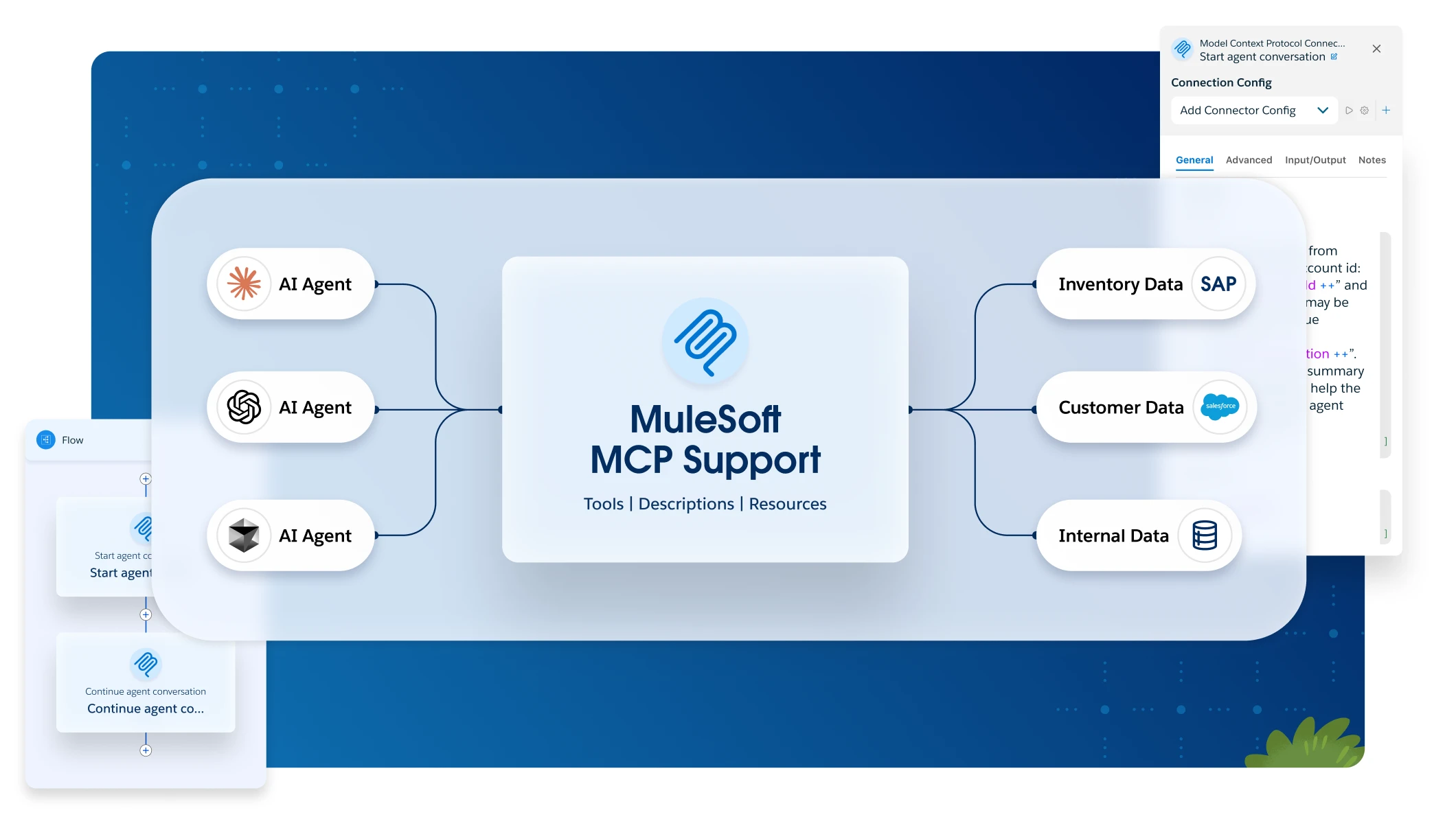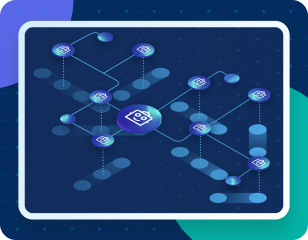The rapid advancement of AI presents an opportunity for organizations to innovate and gain a competitive edge. However, successfully implementing and scaling AI initiatives hinges on a robust and adaptable API strategy. Without a well-defined approach, you risk siloed data, integration challenges, and ultimately, slower AI adoption. In the race to adopt AI, many organizations stumble due to a lack of a solid API strategy. This leads to wasted resources, missed opportunities, and ultimately, a failure to realize the full potential of AI initiatives.
We will explore why APIs are essential for AI and how you can define an API strategy that not only enables efficient AI implementation but also provides the flexibility needed to navigate the evolving AI landscape. We will delve into how combining API-led connectivity with domain-driven architecture creates a powerful foundation for a scalable, secure, and efficient API strategy, using an example of a state Department of Transportation.
Why APIs are essential for AI adoption
AI models thrive on data, and often, that data resides in various systems across your organization. APIs act as abstraction and bridge, enabling seamless and secure access to this data. APIs also make available the actions that encapsulate the business logic of the They break down data silos, allowing AI algorithms to access the information they need to learn and make predictions.
Furthermore, APIs facilitate the integration of AI capabilities into existing applications and workflows, making AI more accessible and impactful across your business. Without a strong API foundation, you’ll likely face significant hurdles in accessing, integrating, and deploying AI solutions effectively. Imagine trying to train a predictive maintenance model for infrastructure without being able to easily access data from sensors, maintenance logs, and weather reports – APIs are the key to unlocking this potential.
AI’s insatiable data appetite demands direct access. APIs are the express lanes, delivering not just data but the very actions AI needs to thrive. They obliterate silos and embed intelligence into your workflows, transforming applications from static to dynamic.
How to create an API strategy for efficient AI implementation
To harness the power of AI, you need a well-thought-out API strategy. This involves several key principles. Embracing API-led connectivity is crucial, as it promotes a modular and reusable approach to integration. By building APIs around specific business capabilities, you create a flexible architecture that can adapt to changing AI needs. Domain-driven design (DDD) is about organizing your systems around core business concepts (domains) to improve alignment and flexibility.
Domain-driven design can further enhance your API strategy by organizing APIs around business domains, ensuring that they are aligned with your organizational structure and business processes. This makes it easier to manage and evolve your APIs as your AI initiatives mature. Additionally, consider principles like API versioning to manage changes without disrupting existing integrations and API governance to ensure consistency and security across your API ecosystem. Finally, zero trust architecture principles are essential for the security and governance for an organization’s data, applications and systems.
Domain-driven design (DDD)
Consider a state Department of Transportation (DOT). A domain-driven approach would identify key business domains such as “Roads,” “Vehicles,” “Traffic,” and “Safety”. Add to that Public Transit, Finance & Grants, and Infrastructure Projects, and you’ll realize that it is a fairly complex multi-domain organization. Instead of building APIs that directly expose the complexities of the underlying systems (e.g. a legacy system for road maintenance and a separate system for vehicle registration), the DOT can create System APIs aligned with these domains.
Here’s a potential list of domains based on Department of Transportation services:
- Roads domain: Focuses on the physical infrastructure of roadways, including their condition, maintenance, and construction.
- Vehicles domain: Centers on vehicles operating within the state, encompassing registration, ownership, and inspections.
- Traffic domain: Deals with the movement of vehicles and people, including flow, incidents, and weather impacts.
- Safety domain: Focuses on ensuring transportation safety through accident data, inspections, and regulations.
- Public transit domain: Encompasses all aspects of public transportation, including routes, schedules, and real-time information.
- Infrastructure projects domain: Focuses on the planning, management, and execution of transportation infrastructure projects.
- Finance and grants domain: Focuses on the financial management of the DOT, including budgets and grants.
API-led connectivity
Agents can leverage an API-led connectivity-fueled strategy to provide information and take actions. Let’s explore this by using a contextual example of a state Department of Transportation (DOT) integrating Agentforce with MuleSoft-managed APIs.
In this scenario, the Roads domain might involve several underlying systems: a GIS system for road locations, a maintenance management system, and potentially an ERP system. Majority of the DOT domains cross the system boundaries, the domain specific System APIs abstract away the complexities of these individual systems, providing a consistent and unified interface. Platforms like MuleSoft enable the rapid creation of these System APIs through the out of the box connectors. Both application and protocol level connectors allow you to connect to virtually any system in no code manner.
The business logic for use cases is implemented in the Process layer. Process APIs leverage the domain specific data and capabilities from the underlying System APIs and orchestrate the business logic through aggregation, enrichment and transformation to offer new functionalities. Experience APIs shape the data from Process APIs and expose to specific channels with the appropriate security measures.
Based on the key principles discussed so far, DOT’s domains and the API layers, let’s see how API Architecture can look like for a state DOT:
The DDD and API-led architecture provides flexible, scalable and secure architecture to support a myriad of projects for the DOT. Domain specific System APIs provide maximum reusability for all the system level APIs for traditional projects and agentic AI implementations.
The domain API for the Road connects to four different systems and makes all the data available in easy to consume standardized format. This hides all the complexity of the systems underneath for the domain. It also allows to sunset the legacy system and replace it with a new system without impacting any of the orchestrations on the layer above the System APIs. This architecture enables the flexibility to apply appropriate security policies both at the individual domain API level and also across the API groups like System APIs.
API-led connectivity allows the DOT to expose its core services (Roads, Vehicles, etc.) as reusable building blocks. This not only speeds up development but also enables greater agility in responding to new citizen needs and AI-driven innovations.
AI agents leveraging APIs beyond information retrieval
AI agents are poised to revolutionize how organizations operate, automating complex tasks, providing proactive assistance, and driving unprecedented efficiency. APIs are the essential foundation for this transformation.
Imagine an AI agent assisting citizens with DOT-related queries. With a well-defined API strategy like the one illustrated above, this agent can do much more than just provide information. Let’s consider a scenario where there is an AI Agent helping internal DOT staff on all the road maintenance related activities. This agent would require to have knowledge and access to following information:
- Unstructured knowledge base: Understand all the processes and rules and regulations around the required activities for a domain
- Real-time domain-specific data: Access real-time data from all the systems that store the domain information.
- Other near-real-time contextual data: Access near-real-time data from the CDP, like Salesforce Data Cloud and CRM to understand the history and context of the user and the conversation
- Set of actions: Take specific actions for the domain area based on the conversation and the on the available action library
Now, let’s take it further to see how DOT can leverage the existing DDD and API Led Architecture to enable quick and efficient AI Implementation. Consider a case where DOT is creating a Road Maintenance Agent that understands the DOT rule, regulations and processes around the road maintenance. It also has access to the CRM and Data Cloud data for understanding the full context of the user. In addition, based on the user query, it also needs to retrieve real-time dynamic information about the domain specific Roads data. And finally, as agentic architecture is beyond answering queries, it needs to have a library of “Road” domain specific actions it can take based on the user needs.
Given this scenario, DOT can create a design for the Road Maintenance AI Agent. It can use the Road System API to retrieve the domain specific data, it can use the sets of actions available in the Road Maintenance APIs to perform the needed actions.
AI Agent will get the knowledge of the processes through Mule AI Chain Connector for the vector database that can be loaded with the DOT knowledge base which is usually in files and web articles. This knowledge base can be auto refreshed on an appropriate schedule to ensure the latest rules and regulations are used in the agent conversations.
Finally, Data Cloud can provide the context and history of the user and user’s past conversations, transactions etc for the personalized responses.
Let’s see how this the existing AP architecture can be extended to get to the optimal agentic architecture for the DOT:
The architecture diagram above depicts how DOT can implement an AI Road Maintenance Agent leveraging the existing APIs, Data Cloud, and Mule-AI-Chain connectors to create optimal retrieval augmented generation (RAG) implementation. Let’s examine the various features of this Road Maintenance AI Agent:
- Taking action: This is where the real power of the API strategy comes in. The AI agent can leverage Process APIs to take actions on behalf of the citizen. If someone reports a pothole, the agent can use a “Report Road Incident” action from the Process API to create a maintenance ticket in the DOT’s system.
- Retrieving knowledge: The agent can use System APIs to retrieve information about road conditions, vehicle registration status, or traffic regulations. If someone asks about the status of a specific road, the agent can use the GET /roads/{roadId}/maintenance System API to fetch the relevant details.
- Guiding processes: The agent can guide the citizen through specific processes, such as applying for a new driver’s license or reporting a road hazard. It can access process guidelines and forms through the Mule AI Chain vector DB connector and provide step-by-step instructions.
- Personalizing steps: Based on the citizen’s profile and previous interactions stored in CRM and Data Cloud, the agent can personalize the steps and information provided.
- Developing a seamless experience: The citizen experiences a seamless interaction, unaware of the underlying API calls and system integrations. The AI agent provides relevant information and takes necessary actions efficiently. The agent can take further actions by identifying the available maintenance vendor and use action “Schedule Road Maintenance” to promptly address the reported issue. Upon completion of the maintenance activity from the vendor, the agent can close the ticket using “Update Road Status” Process API action potentially pre-filling with data retrieved from the System APIs.
Security and governance through API AI gateway
Security is paramount when dealing with sensitive data, especially in the context of AI. Your API strategy must prioritize security at every stage, including:
- Implement robust authentication and authorization mechanisms to control access to your APIs and the data they expose
- Employ encryption techniques to protect data in transit and at rest
- Review and update your security measures to stay ahead of potential threats
Security policies are applied on each System, Process, and Experience API level by MuleSoft API Manager. In addition to the API Group level policies, the domain specific security policies can also be layered in to achieve the desired fine grained entitlement model.
It is also essential to secure the AI Agent’s interaction in every conversation both with the end user and with the Large Language Models. MuleSoft AI Gateway has the policies for the Prompt Guard, Prompt Decorator, Request/Response Transformer, LLM Key Provider, Token Rate Limiting and Prompt Template. Custom policies can also be created and applied to the Agents for desired AI/LLM security requirements.
For the DOT example, access to vehicle information via the GET /vehicles/{vehicleId} API must be strictly controlled, ensuring that only authorized personnel can access this sensitive data. A strong security posture is not just about protecting your data; it’s also about building trust with your customers and partners.
Need for flexibility and future-proofing
AI is constantly evolving, with new models, techniques, and platforms emerging rapidly. Your API strategy must be flexible enough to accommodate these changes without requiring significant rework. By adopting the principles mentioned above,\ you create an architecture that is adaptable and can easily incorporate new AI technologies.
For the DOT example, imagine they want to implement an AI-powered system to predict road conditions based on weather data and sensor readings. With a domain-driven API layer, the AI system can easily access road information via the GET /roads/{roadId} API and integrate with weather APIs and sensor data APIs.
The abstraction provided by the System APIs offers significant advantages for digital transformation of the underlying systems. As shown in the diagram, the DOT’s data might reside in various systems like GIS databases, legacy maintenance systems, ERP systems for vehicle registration, data lakes for traffic sensor data, and even mainframe systems for accident records.
If the DOT decides to replace its legacy road maintenance system, the business logic and AI implementations that rely on the “Roads” System API will not be directly impacted as long as the System API Contract remains consistent. The changes are isolated within the implementation of the System APIs, which can be updated to connect to the new system without disrupting the upper layers. This future-proofing aspect is critical for ensuring that AI investments remain valuable and that you can quickly leverage new advancements in the field.
How does AI benefit from an API strategy?
An effective API strategy lays the groundwork for successful AI adoption by addressing several key challenges:
- Data accessibility: AI models are data-hungry. An API strategy ensures that AI agents and algorithms can easily access the necessary data from various systems without complex point-to-point integrations. The System APIs, as we discussed, abstract away the complexities of the underlying databases, data lakes, and legacy systems, providing a consistent way to retrieve information.
- Seamless integration: AI solutions need to be integrated into existing business processes and applications. Process APIs, built on top of System APIs, encapsulate the business logic and workflows of the organization. This allows AI agents to interact with these processes seamlessly, triggering actions and updating information in a controlled and governed manner.
- Scalability and flexibility: AI is a rapidly evolving field. An API strategy provides the flexibility to incorporate new AI models and platforms without overhauling the entire IT infrastructure. The modular nature of API Led connectivity allows for easy integration of new AI capabilities.
- Security and governance: Security is paramount, especially when dealing with sensitive data. An API strategy enforces security policies and governance at the API level, ensuring that AI agents access data and trigger actions in a secure and compliant manner.
Benefits of this integration
- Improved customer experience: Customers can get their queries resolved and actions taken quickly and efficiently through AI-powered interactions.
- Increased agent productivity: Customer service representatives can focus on more complex issues, as routine tasks and information retrieval are handled by the AI.
- Data-driven decision-making: The interactions and data collected can provide valuable insights for the DOT to improve its services and processes.
- Enhanced efficiency: Automating processes through AI agents and APIs reduces manual effort and streamlines operations.
By adopting a robust API strategy, your organization like the DOT can empower AI agents to become valuable assets, enhancing citizen/customer services, improving operational efficiency, and driving innovation. The combination of Salesforce’s AI capabilities and MuleSoft’s full lifecycle integration prowess provides a powerful platform for implementing such a strategy.









